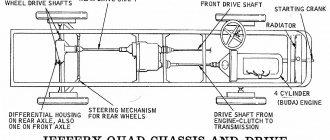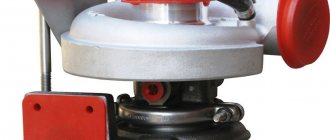The Volvo FH 12 is a large truck tractor that can be used as part of a road train with a total weight of up to 60,000 kg. The car is usually used for long-haul transportation. The series includes several modifications with wheel formulas four by two, six by four, six by two and eight by two.
The Volvo FSH 12 family replaced the F Cabover model and immediately became very popular. Thanks to the availability of many versions with different types of cabins, wheelbases and designs, buyers could choose a model for specific purposes, and the legendary quality of the Swedish brand, coupled with high safety, made the car one of the leaders in the segment.
Model history and purpose
In 1993, car maker Volvo began production of the FH family of heavy-duty vehicles, which was cutting-edge at the time. It replaced the F Cabover series in the lineup, which had been in production for almost 15 years. The development of the new product was carried out almost from scratch, and its duration (from the first drawings to launch into series) was 7 years.
Initially, the family included only 2 modifications. The first version had 12-liter D12A units with a direct injection system, the second had 16-liter D16A engines. The remaining elements of the models turned out to be almost the same. The cabin of the Volvo FSH 12, unlike its predecessor, had a more streamlined shape, an increased level of comfort and safety. The series quickly found a buyer and occupied its niche in the market.
In 1998, the Swedish brand decided to restyling the model. Externally, the car has remained virtually unchanged. Only the aggregate component has undergone significant transformations. The D12C engine with a power of 460 hp appeared in the line of engines. The subframe design has also been improved. Due to the emergence of a powerful engine, the transmission had to be modernized. The new gearbox made it possible to increase torque to 2500 Nm, reducing the effort when switching gears by half. The manufacturer also changed the electronic control system, and all the data needed by the driver was now displayed on an LCD screen located in the cockpit.
In the early 2000s, Volvo introduced the second generation FH 12. Global changes occurred in the design of the cabin, which was transformed beyond recognition, receiving a more streamlined shape. Its length has increased by 150 mm, new mirrors and headlights have appeared, and the interior has become more comfortable. The corners of the panels received rounded contours. The assembly part has also changed. The family received more powerful and economical D12D power plants and a semi-automatic with the I-shift system. Later, the engine line included engines with 550, 610 and 660 hp. In 2005, the list of units for the Volvo FSH 12 was supplemented with 13-liter D13A engines with a power of 360-520 hp. The installations complied with Euro-3 requirements.
In 2008, the debut of a restyled version of the car took place. The Swedish brand paid primary attention to increasing comfort and safety. The updated versions of the Volvo FH 12 II added a rain sensor, adjustable seats, a lane crossing system, a light level sensor and a blind spot radar. The external design has changed slightly. There is a new radiator grille and headlights. In 2011, production of flagship models with a 750-horsepower unit began.
Since 2012, the Volvo brand has introduced the third generation of FH 12 trucks, which for the first time received an independent front suspension articulated with a rack and pinion steering system. The model was radically different from its predecessor, having received many new elements. The cabin elements were pressed using a unique technology, which gave impeccable quality. The car was offered with a Powertronic automatic or I-Shift semi-automatic. The cabin was built on a single frame with a large radiator grille, an emergency hatch and daytime lights. It was available in three versions:
- standard with sleeping places for one person;
- Globetrotter with high altitude and sleeping bags for two people;
- Globetrotter XL with increased height and sleeps two people. The most top-end and comfortable option.
Modifications of the third Volvo FSh 12 also differed in chassis height (ultra-low, low, medium, high) and power plants (9 units with power from 420 to 750 hp).
The main features of the Swedish truck (reliability, increased safety and high quality) have been preserved.
The Volvo FH 12 model had a narrow specialization and was designed exclusively for transporting large volumes of cargo over various distances. At the same time, the car was additionally adapted to work in difficult conditions, so Russian realities were not scary for it.
Cost of work when repairing a VOLVO gearbox:
| car entry diagnostics | for free |
| removal and installation | 5,000 rub. |
| disassembly and assembly | 5,000 rub. |
| Replacing the clutch at the request of the car owner | 2,000 rub. |
| filling the gearbox with transmission oil | for free |
A range of services for repairing a VOLVO manual gearbox
Warranty from 3 to 24 months or 60,000 km. mileage
| Phone number of the repairman: | Artem 8 /965/ 126 13 83 Vadim 8 /925/ 675 78 75 |
| Tow truck assistance /24/7/, dispatcher: | 8 /926/ 167 15 40 8 /985/ 888 68 14 |
We have a stock of restored manual transmissions /see article replacement/. If the car owner wishes, we can replace the faulty one with one taken from the exchange stock, which is often more economically feasible.
Purpose
The Volvo FH12 is a typical European-style mainline model. Models of the FH series are designed for operation both as single vehicles with a gross weight from 18 to 32 tons, and as part of long-haul road trains with a gross weight of up to 60 tons. The Volvo FH12 model is designed for transporting goods on highways and paved highways over long distances. Over the long history of operation, the machine has shown its high reliability during operation in all regions of Russia, from Kaliningrad to the Far East. A key driver of truck profitability is the total cost of ownership. Volvo FH12 has optimal characteristics that increase the profitability of transportation. This makes the model popular with both private carriers and large transport companies.
The lineup
REPAIR of VOLVO gearboxes of all models of MANUAL GEARBOXES VOLVO gearbox repair and restoration of shafts argon welding of manual transmission housing Moscow city
Artem Vadim
Complete vehicle diagnostics during repairs – free of charge!
Having a high level of professionalism, extensive experience in repairing manual transmissions, and our own warehouse of spare parts, we carry out diagnostics, sale, replacement and repair of all types of manual transmissions for VOLVO cars. Box repair begins with an initial, mandatory free diagnosis.
Specifications
It is quite difficult to make a truck suitable for all areas of transportation. The Volvo FH series of trucks is designed in such a way that it makes it possible to quickly prepare the vehicle for the installation of almost any body superstructure. Various combinations of engines and transmissions, suspensions and cabs, and their configurations allow the Volvo FH12 to be used as tractor units, chassis, flatbed trucks and dump trucks. Four types of cabins are installed on the machine:
- Short daytime;
- Extended with one berth;
- "Globetrotter" (wanderer) with two berths;
- "Globetrotter XL" with an internal cabin height of 210 cm.
Fuel tanks are installed on both sides of the frame and can have a volume of: 560+420, 610+530, 800+400.
For a truck tractor in the basic configuration, the main parameters are as follows:
- Length – 5865 mm;
- Width – 2467 mm;
- Height – 3199 mm;
- Wheelbase – 3500 mm;
- The vehicle's own weight is 6480 kg;
- The permissible total weight of the tractor is 19,700 kg;
- Engine type – in-line, turbocharged diesel;
- Number of manual transmission gears – 14;
- Suspension type: front spring, rear pneumatic;
- Brakes – front and rear disc;
- Tire size – 315/70R22.5.
In addition to installing a simple manual gearbox, there is an I-Shift automated gear shift system that saves the driver from about two thousand shifts a day. In addition, the Volvo FH12 is equipped with a Powertronic automatic transmission.
Engine
The truck is equipped with diesel, economical, productive and reliable power units. At the same time, they are quite demanding on the quality of fuel, so it is worth filling only with high-quality diesel fuel, otherwise the service life of the Volvo FH12 engine will be greatly reduced.
The F12 powertrain line includes 9 engines. The most popular (including in our country) is the 12-liter D12A engine, with a power of 460 “horses” with an intercooler and a turbo compound, which makes it possible to increase such high power.
With such an engine, a loaded truck can accelerate to ninety kilometers per hour. Average fuel consumption in city mode is 42 liters per hundred kilometers, and on the highway it is 6 liters less. The fuel tank capacity reaches almost 700 liters. The tanks are made in the shape of the letter D.
Consider a 13-liter unit that is equipped with a turbocharger. The device is offered in 4 different power options. The maximum torque ranges from 1800 to 2400 Hm.
| Characteristics | Indicators |
| Maximum speed | 90 km/h |
| Average fuel consumption on a free highway | 36 l/100 km |
| Main fuel tank capacity | 690 l |
| Additional fuel tank capacity | 490 l |
| Engine displacement | 12130 cu.m. cm |
Both presented FH12 engines are in-line, have six cylinders and turbine supercharging. They meet Euro-4 environmental standards and emit low amounts of CO2.
Transmission
Transmission – manual gearbox with 9 or 14 speeds. In addition, the truck is equipped with a 12-speed manual transmission with the “I-Shift” system, which is electronically controlled and has a joystick with 5 switch positions. It is this gearbox that has gained the greatest popularity in Russia.
Its specificity is in the remote control unit, which makes changes to the operation of the pneumatic system that controls the operation of the clutch.
The control unit constantly receives information about the vehicle's movement characteristics. He processes it and then switches gears. The unit operates together with a device responsible for adjusting the speed of rotation. Gears are switched automatically thanks to modern software. If necessary, you can select the gears yourself using the keys on the selector.
This transmission has several driving modes. For example, if you turn on the economy mode, the gearbox will begin to switch gears very accurately, selecting the best range of operation of the Volvo FH12 engine.
It is worth noting the very interesting “I-Roll” function, which automatically turns off the engine while descending a slope. This allows you to reduce fuel consumption by almost 2%.
When switching to the powerful mode, the car noticeably increases in dynamics and sharpness, although it also consumes much more diesel fuel.
When overtaking, it is better to use the kick-down mode, which is activated by pressing the corresponding key. This is a mode in which the car quickly picks up the maximum possible speed.
Chassis
The model's chassis has the latest modular design with the simplest body connection. The rear axle of the car has a single-stage gearbox. There is an independent suspension at the front, and a dependent pneumatic suspension at the rear. Add-ons are connected with an original electronic module.
All axles of the machine are equipped with disc brakes, which significantly improves braking efficiency. The latest generation version, even in the cheapest configuration, includes an anti-lock braking system, which provides reliable control in an emergency. The Volvo FH12 also has electronic stability control, which allows you to prevent skidding by using a computer to control the torque of one or more axles. Such electronic assistants play a big role in traffic safety, reducing the number of accidents.
The steering is traditionally designed with a hydraulic booster, which greatly facilitates turning the steering wheel. The car handles well on the road, is almost not afraid of ruts, and there is no body roll.
Chassis elements effectively absorb vibrations and shocks that occur during driving, which ensures comfort when driving on low-quality road surfaces.
Just drive the car
I-Shift makes driving easier, safer and more comfortable. There is no heavy clutch mechanism or lever that requires effort to shift. Gear shift moments are perfectly timed. The simplicity of the system reduces driver fatigue, allowing you to concentrate on the road and the movement of other vehicles. If the driver wants to change gear manually, a button on the shift lever can be used to provide direct control of the gearbox.
Device
The Volvo FSH 12 chassis has an advanced modular design with the most simplified body connection. The rear axle of the model is equipped with a single-stage gearbox. The car uses independent front suspension and dependent pneumatic rear suspension. To connect add-ons, a unique Bodybuilder electronic module is used.
Disc brakes are used on all wheels. The latest generation of the truck already received ESP and ABS systems in the basic version. The first (installed on a car of this class for the first time) provides reliable control over the car in any conditions, the second helps provide better braking.
The Volvo FH 12 is equipped with 2 types of gearboxes. The first is a completely new transmission with the I-Shift system. Due to the lack of synchronizers, it is significantly shorter and lighter than a standard gearbox. The second was a 12-speed synchronized transmission with By Wire control. It requires less effort to switch gears and works much more clearly.
The most common in Russia are versions with a gearbox with the I-Shift system, which are considered an example of ultra-modern transmissions. Their peculiarity lies in the fly-by-wire control unit, which allows you to regulate the operation of the pneumatic system that controls the operation of the gears and clutch. The control unit regularly receives data on the truck's movement parameters. After processing, it switches speeds. The unit works in conjunction with a unit that provides speed control and, when the optimal mode is reached, activates the engine brake effect. Automatic gear selection is achieved through intelligent software. If desired, the driver can independently select gears using the shift button located on the selector.
There are several travel modes available for this transmission. In economy mode (E), the gearbox switches speeds with maximum precision, choosing the optimal range of engine operation. Another useful feature is the I-Roll function, which automatically turns off the unit when driving downhill. Thanks to this function, fuel consumption is reduced by 2%. In powerful (P) mode, the car becomes more dynamic, but consumes more fuel. The difference is felt immediately. When overtaking, the driver can use the kick-down button.
Compared to its predecessor, the cabin volume has increased by 1000 liters. Approximately 30% of the additional space went to increase the luggage compartment. The latest ergonomic curved instrument panel has been installed in the cabin, guaranteeing quick access to any information about the vehicle. The steering column is adjustable in height and angle, which makes steering more comfortable. The I ParkCool air conditioning system ensures less fuel consumption. Bed comfort has improved significantly. The head part of the shelf in the latest generation Volvo FSH 12 was made adjustable, and the lower part was increased in width by 40 mm. A control panel has appeared at the berth, through which the air conditioning system, sunroof, interior lighting, media system and heating are controlled. They can be adjusted directly from the shelf. There are also many additional shelves and storage spaces. Top versions have a retractable display.
Maintenance intervals for the third Volvo FH 12 were increased by 20%, which reduced maintenance costs.
The model has practically no disadvantages. Its main disadvantage is considered to be quite high cost. However, it is a fair price to pay for the highest quality and advanced technology that makes the Volvo FSH 12 one of the best carriers in the world.
Description
How to shift correctly on a VOIVO FM X dump truck. In the design of three-speed gearboxes there is a divider, thanks to which we get an additional series of speeds (that is, 3 more speeds) and a multiplier, which from the existing 6 speeds gives 6 more, plus the reverse speed also splits into 2 , in total there are 12 forward speeds and 2 reverse. These are the most popular boxes, have a reliable design, are easy to maintain, replaced the older SR1700 and SR1900 models, have proven themselves well among owners of Swedish brand trucks, are produced by the manufacturer and are installed on the assembly line to this day. All models have the same gear ratios at all speeds and differ only slightly in internal details. We can highlight the VT2814B model; the manufacturer positions this gearbox as the strongest, i.e. designed for greater torque from the engine (2800 N/m) differs in other gears of the third gear and divider. The line of these gearboxes also includes higher-speed gearboxes with a direct-drive gear ratio of 0.8, the so-called OverDrive gearboxes, used on chassis with final drives installed on the drive axles. You can identify the transmission model on your truck by the nameplate on the clutch housing, or by the VIN code. If we look deeper into the design, we will see the main 3 gears equipped with synchronizers (3rd gear synchronizer, working in one direction, and double synchronizer of 1st and 2nd gears, installed respectively between the 1st and 2nd gear gears), a divider synchronized in both directions, not synchronized low-speed and reverse gears, and also equipped with a synchronizer in both directions, the output shaft of the gearbox, also known as a planetary gearbox, also known as a range multiplier. The main malfunctions that occur in the gearbox itself are: spontaneous switching off of gears, failure to engage gears, a crunching sound when shifting gears, a knocking sound from the gearbox when the car is stationary and the engine is running, noise from the gearbox when driving, increased temperature of the gearbox (above 65 degrees, you can’t hold your hand) - loss of oil and jamming of the gearbox. Instagram—https://www.instagram.com/p/B8D8IeBHgF4/?igshid=10yju2x82rzsm
Subscribe to our Telegram channel! @thewikihow open We monitor video trends 24/7
Share with friends:
Add a timestamp
Exterior
The model has a stylish and modern design; smooth lines along with streamlined contours give its appearance purposefulness and effectiveness. The image of the Volvo FH12 truck is assertive and even a little aggressive. Externally, a very large radiator attracts attention, which goes well with large optical headlights made in an interesting shape.
The appearance of the tractor turned out to be energetic, accentuated and even a little futuristic.
Innovative ideas affected the design of optical instruments. The car has vertical headlights, which easily distinguish it from other models, despite the logo.
Modifications
The updated Volvo FH series range consists of four chassis variants for truck tractors and three variants for flatbed trucks and road trains. The chassis is equipped with spring and air suspension in various combinations. The first generation Volvo FH12 cars were equipped with 12.1 liter engines. In 2005, the Volvo FH13 model with a 12.8 liter engine was introduced. It replaced the previous model on the production line. At the same time, the markings on the front panel of the FH12 cockpit were replaced with the letter designation FH, avoiding the use of an unlucky number. In 2002, the second generation of the line received an updated cabin. In September 2012, the third generation of FH series cars equipped with independent front suspension (IFS) connected to a rack-and-pinion steering mechanism was presented at the Hannover Automobile Exhibition. The cars received a completely new chassis and cabin. Only power plants that underwent modification were taken from previous modifications. Two years later, the third generation Volvo FH received the prestigious “Truck of the Year” award.
Features and operation
Swedish Volvo FH12 tractors are equipped with an electronically controlled air suspension that provides automatic height adjustment. By compensating for unevenly distributed loads, the height of the platform is always constant. The height can also be changed using a hand controller or multiple values can be set using the programming function. To increase the vehicle's profitability, much attention is paid to fuel economy. The engines use vertical pump injectors located in the center of the cylinder, and the geometry of the combustion chamber is optimized. The I-Shift system monitors the weight of the truck, its speed and acceleration taking into account the slope of the road, allowing you to save up to 5% of fuel. If the first Volvo FH12 models were typical representatives of the pre-electronic era, then in the third generation of FH series machines more and more new electronic systems appear. The I-See function (I see) automatically downloads topographical path data from the server, and after processing it, sends the necessary signals to the engine and transmission. This allows the vehicle's kinetic energy to be harnessed, reducing fuel consumption and CO2 emissions.
The Volvo automobile concern, like no other, pays increased attention to safety. Volvo FH cars feature adaptive cruise control, which allows you to maintain a safe distance from the vehicle in front. The system also warns the driver of danger and activates emergency braking mechanisms. When developing the cabs, every part of the cab was tested for impact loads. In addition, glass roofs are installed in the cabin of each FH series vehicle, serving as an escape hatch in an emergency.
The third generation FH series vehicles feature two systems that take the truck's handling to a new level. The use of independent front suspension and dynamic steering make the car stable when taking even sharp turns at any speed. According to the developers, the new design made it possible to increase the vehicle's directional stability by 50%. The IFS independent suspension installed on Volvo FH vehicles is the first time the company has installed it on mass-produced trucks.
The Volvo FH driver's level of comfort is traditionally high. The dynamic steering wheel can be turned with one finger. The electronically controlled suspension during loading and unloading operations can be controlled using a remote control while in or near the machine cab. In the cabin, every detail is thought out, regardless of whether the driver is behind the wheel or resting on a berth. There are multiple shelves for storing personal items. The I-Park-Cool system allows you to maintain a comfortable temperature in the cabin during stops, depending on the weather outside. The system is installed in such a way that it does not affect the aerodynamics of the car and does not lead to excessive fuel consumption when driving. The cabin even has an electric clothes and shoe dryer.
The third generation Volvo FH cars feature the most advanced technologies, and ergonomically located controls allow you to not make unnecessary movements and be distracted from the road. Twin rearview mirrors almost completely eliminate the presence of blind spots. The low-mounted engine compartment allows you to move freely around the cabin. All conditions for work and productive rest of the driver are created in the car cabin.
Description
How to shift correctly on a VOIVO FM X dump truck. In the design of three-speed gearboxes there is a divider, thanks to which we get an additional series of speeds (that is, 3 more speeds) and a multiplier, which from the existing 6 speeds gives 6 more, plus the reverse speed also splits into 2 , in total there are 12 forward speeds and 2 reverse. These are the most popular boxes, have a reliable design, are easy to maintain, replaced the older SR1700 and SR1900 models, have proven themselves well among owners of Swedish brand trucks, are produced by the manufacturer and are installed on the assembly line to this day. All models have the same gear ratios at all speeds and differ only slightly in internal details. We can highlight the VT2814B model; the manufacturer positions this gearbox as the strongest, i.e. designed for greater torque from the engine (2800 N/m) differs in other gears of the third gear and divider. The line of these gearboxes also includes higher-speed gearboxes with a direct-drive gear ratio of 0.8, the so-called OverDrive gearboxes, used on chassis with final drives installed on the drive axles. You can identify the transmission model on your truck by the nameplate on the clutch housing, or by the VIN code. If we look deeper into the design, we will see the main 3 gears equipped with synchronizers (3rd gear synchronizer, working in one direction, and double synchronizer of 1st and 2nd gears, installed respectively between the 1st and 2nd gear gears), a divider synchronized in both directions, not synchronized low-speed and reverse gears, and also equipped with a synchronizer in both directions, the output shaft of the gearbox, also known as a planetary gearbox, also known as a range multiplier. The main malfunctions that occur in the gearbox itself are: spontaneous switching off of gears, failure to engage gears, a crunching sound when shifting gears, a knocking sound from the gearbox when the car is stationary and the engine is running, noise from the gearbox when driving, increased temperature of the gearbox (above 65 degrees, you can’t hold your hand) - loss of oil and jamming of the gearbox. Instagram—https://www.instagram.com/p/B8D8IeBHgF4/?igshid=10yju2x82rzsm










